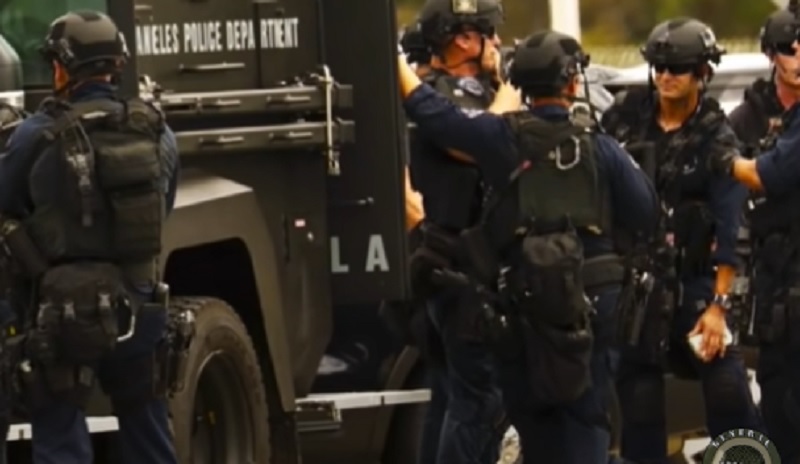
Daryl Gates, a Los Angeles police Inspector nearing his 20th year of service with LAPD during the Watts riots of 1965, is often credited as the “Father of SWAT”, a small, specially trained, and equipped unit of police officers created to deal with unique tactical challenges beyond the ability of a normal police response. In his biography, Gates states that he did not develop SWAT tactics or equipment, but did advocate for the concept which was met with initial resistance from the higher-ups.
Others will identify LAPD officer John G. Nelson as presenting the concept to Gates who promoted the idea. Meanwhile, in 1964 in Philadelphia, a special squad of 100 officers was formed to be a rapid response force to an alarming increase in violent bank robberies. The Acronym SWAT has stood for Special Weapons Attack Team but quickly evolved into a more palatable Special Weapons And Tactics moniker. Variations include HRT (hostage rescue team), STAR (supplemental tactics and response), QRT (quick response team), CIRT (critical incident response team), ESU (emergency service unit), SRT (special response team), SOG (special operations group) and other labels.
The National Tactical Officers Association defines SWAT as “A designated law enforcement team whose members are recruited, selected, trained, equipped and assigned to resolve critical incidents involving a threat to public safety which would otherwise exceed the capabilities of traditional law enforcement first responders and/or investigative units”.
The unrest and rise in violent gang, drug, and political violence of the 1960s included snipers, fortified drug houses, major robberies, and mass disturbances. Gates is reported to note that during the Watts riots, even the massive response of National Guard units was not effective without special training and appropriate equipment.
The effectiveness and safety of these special teams have resulted in an increase in their deployment and are now often a component of smaller agencies in addition to their urban law enforcement colleagues. Most SWAT teams around the country are made up of officers who have regular duties and are on call for SWAT. Only large urban agencies with high critical incident call volume, rescue operations, and frequent high-risk warrant executions maintain full-time teams.
In some areas, the tactical teams are multi-jurisdictional where officers from various police departments train together for response in any of their communities. Agencies with no tactical teams typically have mutual aid agreements with the jurisdiction with a team. Even where agencies have a team there can be situations, like hostages or barricaded suspects that can last for hours beyond a normal operational period where relief and backup teams become necessary.
Specialties within SWAT teams vary, and many members can be cross-trained in case a team member with expertise is incapacitated. For example, a dynamic entry specialist may have expertise in using explosive charges, using distraction devices, or heavy entry tools. Emergency medicine, sometimes a licensed physician, is an important area for staffing in high-risk operations where life-saving care may be needed for an officer, suspect, or victim. Sniper training is another specialty that takes a great deal of ongoing training to maintain proficiency in both marksmanship and judgment.
SWAT teams are the only place where police officers are equipped with automatic weaponry (machine guns), but that type of weapon is of very limited value and rarely deployed. Specialized equipment and tools for SWAT teams may include armored rescue vehicles, robots, special cameras, and various distraction devices like stun grenades, smoke canisters, and chemical irritants that can be launched from a distance.
Dramatic scenes of SWAT use from the Black Panther stand-off in 1969 in which thousands of rounds of ammunition were fired over four hours, to the 1974 Symbionese Liberation Army (SLA – famous for the Patty Hearst kidnapping and brainwashing) shootout that resulted in six SLA members dying and the house in which they had holed up burned to the ground, likely as a result of a tear gas canister with a combustible fuse.
In the mid-70s the art of hostage negotiation was added to tactical operations, which influenced teams to contain and hold with the hopes that surrender would preclude further violence. With the failure of this strategy at the Columbine school massacre, active shooter response now relies largely on the first responding officer, whether alone or specially equipped or not, to immediately enter the killing zone and confront the attackers.
SWAT teams have been criticized (of course) for influencing the militarization of local law enforcement. These teams were created to respond to extraordinary risks to the public and serve to preserve life with their special weapons and tactics. With nearly 100,000 SWAT operations annually across the country, their success is well documented and their failures (such as the 1993 raid on the WACO Branch Davidian compound and the 1973 incident at Wounded Knee) are carefully reviewed for continued improvement.